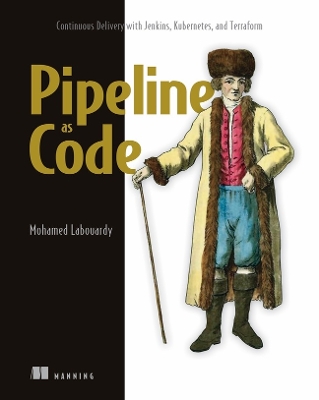L’articolo è stato aggiunto alla lista dei desideri
IBS.it, l'altro eCommerce
Pipeline as Code: Continuous Delivery with Jenkins, Kubernetes, and Terraform
Cliccando su “Conferma” dichiari che il contenuto da te inserito è conforme alle Condizioni Generali d’Uso del Sito ed alle Linee Guida sui Contenuti Vietati. Puoi rileggere e modificare e successivamente confermare il tuo contenuto. Tra poche ore lo troverai online (in caso contrario verifica la conformità del contenuto alle policy del Sito).
Grazie per la tua recensione!
Tra poche ore la vedrai online (in caso contrario verifica la conformità del testo alle nostre linee guida). Dopo la pubblicazione per te +4 punti
Altre offerte vendute e spedite dai nostri venditori



Tutti i formati ed edizioni
Promo attive (0)
"Don't setup the build pipeline with clicks, read this bookinstead and thank me later!" - Michal Rutka Learn how to think about your development pipeline as amission-critical application, with techniques for implementing code-driven infrastructure and CI/CD systems using Jenkins, Docker, Terraform, andcloud-native services. In Pipeline as Code, you will master: * Building and deploying a Jenkins cluster from scratch * Writing pipeline as code for cloud native applications * Automating the deployment of Dockerized and Serverless applications * Containerizing applications with Docker and Kubernetes * Deploying Jenkins on AWS, GCP and Azure * Managing, securing and monitoring a Jenkins cluster in production * Key principles for a successful DevOps culture Pipeline as Code is a practical guide to automating your development pipeline in a cloud-native, service-driven world. You'll use the latest infrastructure-as-code tools like Packer and Terraform to develop reliable CI/CD pipelines for numerous cloud-native applications. Follow thisbook's insightful best practices, and you'll soon be delivering software that's quicker to market, faster to deploy, and with less last-minute production bugs. about the technology A good deployment pipeline is the backbone of successful DevOps. Using tools such as Jenkins, CI/CD can seamlessly manage the code of multiple developers, with early accuracy checks and error spotting thanks to automated testing. about the book Pipeline as Code teaches you to build your very first CI/CDpipeline with new automation technologies, modern cloud-hosted services, andclassic tools like Jenkins. It's filled with techniques that author and Jenkins contributor Mohamed Labouardy has developed maintaining thousands of production services. Each chapter includes relevant hands-on examples, including writing a CI/CD workflow for serverless AWS Lambda-based applications, and deploying a centralized logging platform based on the ELK stack. You'll explore cutting-edge methods of running Jenkins inside Kubernetes, and packaging Kubernetes applications within CI/CD pipelines. By the time you're done, you'llbe able to deploy a self-healing Jenkins cluster on cloud and take advantage ofyour new pipeline with essential DevOps practices. about the reader For developers familiar with Jenkins and Docker. Examples in Go. about the author Mohamed Labouardy is the CTO and co-founder of Crew.work, and aDevSecOps evangelist. He is the founder of Komiser.io, an author, open-source contributor, and regular conference speaker.
L'articolo è stato aggiunto al carrello
Le schede prodotto sono aggiornate in conformità al Regolamento UE 988/2023. Laddove ci fossero taluni dati non disponibili per ragioni indipendenti da IBS, vi informiamo che stiamo compiendo ogni ragionevole sforzo per inserirli. Vi invitiamo a controllare periodicamente il sito www.ibs.it per eventuali novità e aggiornamenti.
Per le vendite di prodotti da terze parti, ciascun venditore si assume la piena e diretta responsabilità per la commercializzazione del prodotto e per la sua conformità al Regolamento UE 988/2023, nonché alle normative nazionali ed europee vigenti.
Per informazioni sulla sicurezza dei prodotti, contattare productsafetyibs@feltrinelli.it
L’articolo è stato aggiunto alla lista dei desideri

